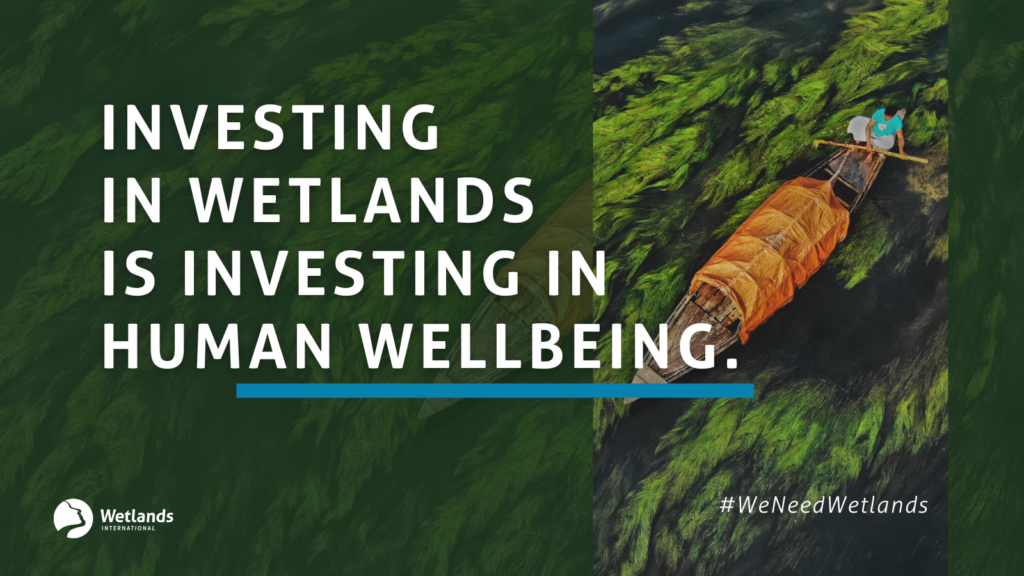
Human wellbeing is irrevocably tied to the state of the world’s wetlands
Authors: Dr. Musonda Mumba: Secretary General of the Ramsar Convention on Wetlands and Han de Groot: CEO, Wetlands International
From filtering water to mitigating climate change and supporting livelihoods, wetland ecosystems provide vital services that sustain us.
Wetlands are essential, unique, biodiverse, ecosystems. They may be saltwater or freshwater, inland or coastal, natural, or human-made, permanent, or temporary, static, or flowing. Currently, wetlands cover about 6% of the Earth’s land surface.
Yet, wetlands are the Earth’s most threatened ecosystem. Two-thirds of the world’s largest rivers are no longer free-flowing. Wetlands continue to be lost three times faster than forests. Human activities like drainage, conversion, and damming have fragmented and damaged wetlands the world over. And in 2023, we felt the effects of lost and degraded wetlands on our wellbeing.
Overexploitation of groundwater for intensive and illegal agriculture left Doñana, one of Europe’s largest remaining wetlands, facing a severe drought, harming legitimate farmers and their crops as well as a horde of local and migratory fauna. Rapid urbanisation led to the encroachment of riverbanks and marshlands, flooding Chennai, one of India’s largest cities. Lithium mining in the High Andean wetlands of South America threatened the availability of freshwater for local farmers and the iconic flamingo. Lakes and rivers in the Amazon rainforest dried up in ways we have never seen before, affecting the hundreds of thousands of people who rely on it for food, water, and transportation.
Going further back, in 2022, China’s largest river the Yangtze, reached such low levels that if affected hydroelectric power generation and river transportation. A similar fate affected the Mississippi, forcing the government to dredge the river just so barges could float. Dams and other ill-advised economic development projects have degraded Sahelian wetlands, threatening lives and livelihoods and causing people to migrate. In Indonesia, the clearing of mangrove forests has left its coasts more vulnerable to storm surges and sea level rise.
Degraded wetlands have a compounding adverse impact on our welfare, affecting our access to clean water, disrupting our livelihoods, and impacting the delicate balance of ecosystems that are essential to us.
It is amply evident that the loss and degradation of wetlands over the past few years has affected us negatively, and even disproportionately, with vulnerable communities and ecosystems bearing a heavier burden than others. Even over the next decade, climate and environmental risks are predicted to be in the top 5 threats to affect us.
But the good news is that investing in wetlands is investing in human wellbeing.

Wetlands are nature’s own solution to the climate emergency. They capture and store more atmospheric carbon than any other ecosystem on Earth. Peatlands, though covering only 3% of the planet’s surface, store about 30% of land-based carbon. Coastal blue carbon ecosystems like mangroves, seagrass beds, and salt marshes account for approximately half of the total carbon sequestered in ocean sediments.
Wetlands protect us from the effects of climate change. Mangroves and other coastal wetlands safeguard shorelines against storm surges and sea level rise. Peatlands act like sponges, regulating the flow of water and reducing the impacts of both droughts and floods. In fact, an acre of wetland can store up to 1.5 million gallons of floodwater.
Wetlands also provide nearly all our freshwater. Even though Earth is a “blue planet,” less than three percent of its water is fresh, and most of that is inaccessible. In fact, only about 0.3 percent of our fresh water is found in the surface water of lakes, rivers, and swamps – which are all wetlands. Wetland soils and plants filter bacteria, viruses, and metals, cleaning the waters that pass through them. Wetlands are so central to the water cycle that a world without wetlands would be a world without freshwater.

From the Indus Valley Civilization in South Asia to the Mayan Civilisation in Central America, wetlands have underpinned human development for thousands of years and can continue to do so in a sustainable manner. They provide more than one billion livelihoods across the world – through aquaculture, crop production, transport, and tourism. Fish harvested from wetlands provide the primary source of protein for more than one billion people and rice paddies feed 3.5 billion people annually. A report by WWF estimates the annual economic value of water and freshwater ecosystems to be USD58 trillion – equivalent to 60% of global GDP. Urban wetlands can also support local biodiversity while providing space for citizens to connect with nature and improve their mental and physical health.
It is abundantly clear that healthy wetlands are at the centre of human wellbeing and prosperity. Wetlands exist in every country and restoring them while addressing the drivers of their loss should therefore be a priority for all governments.
